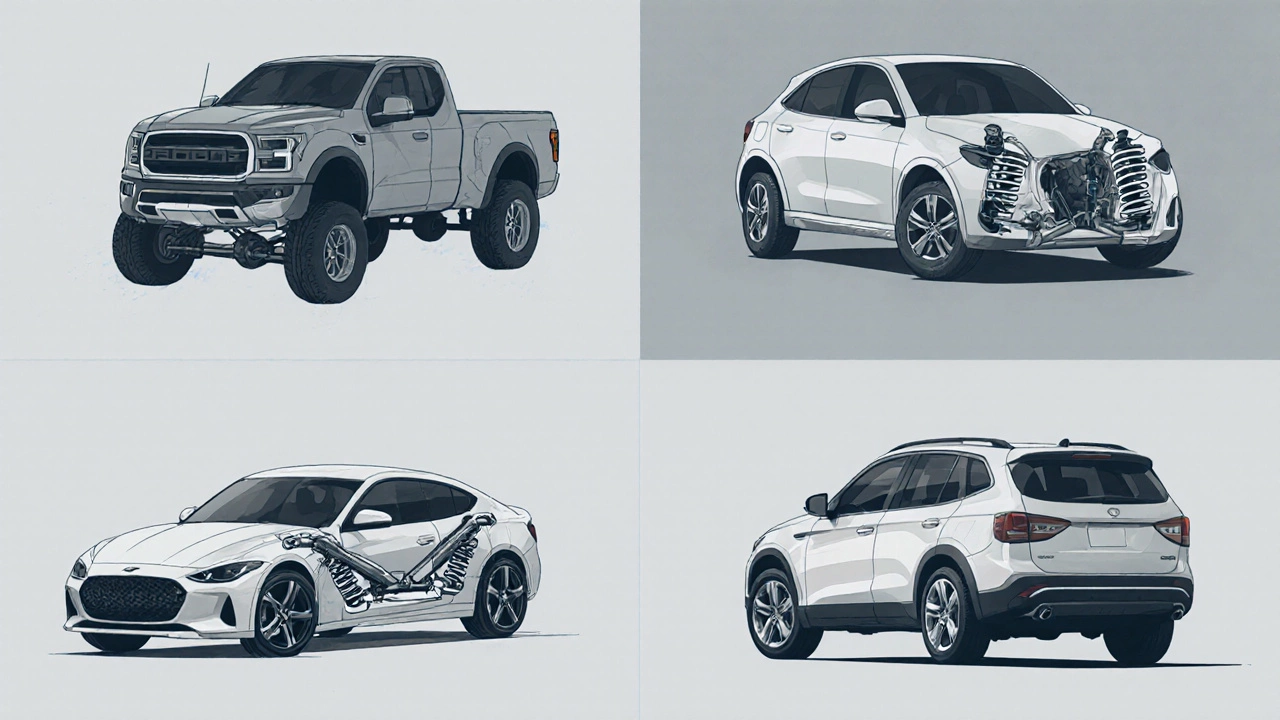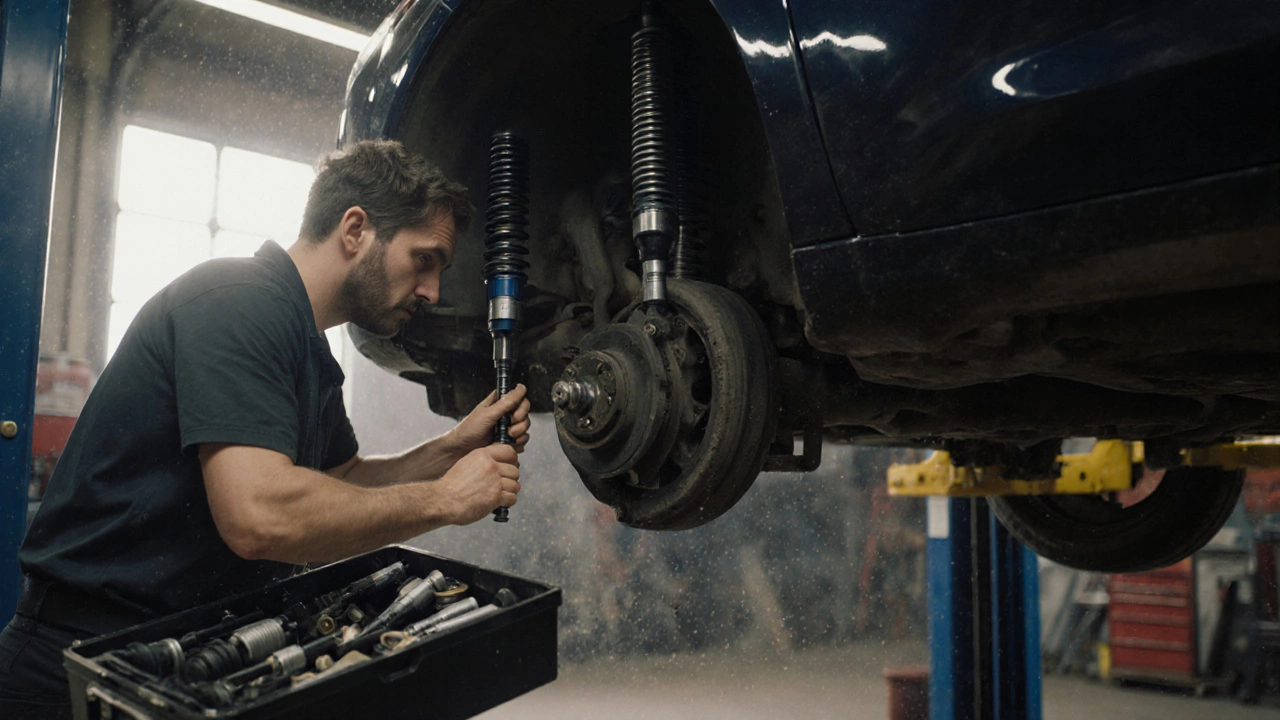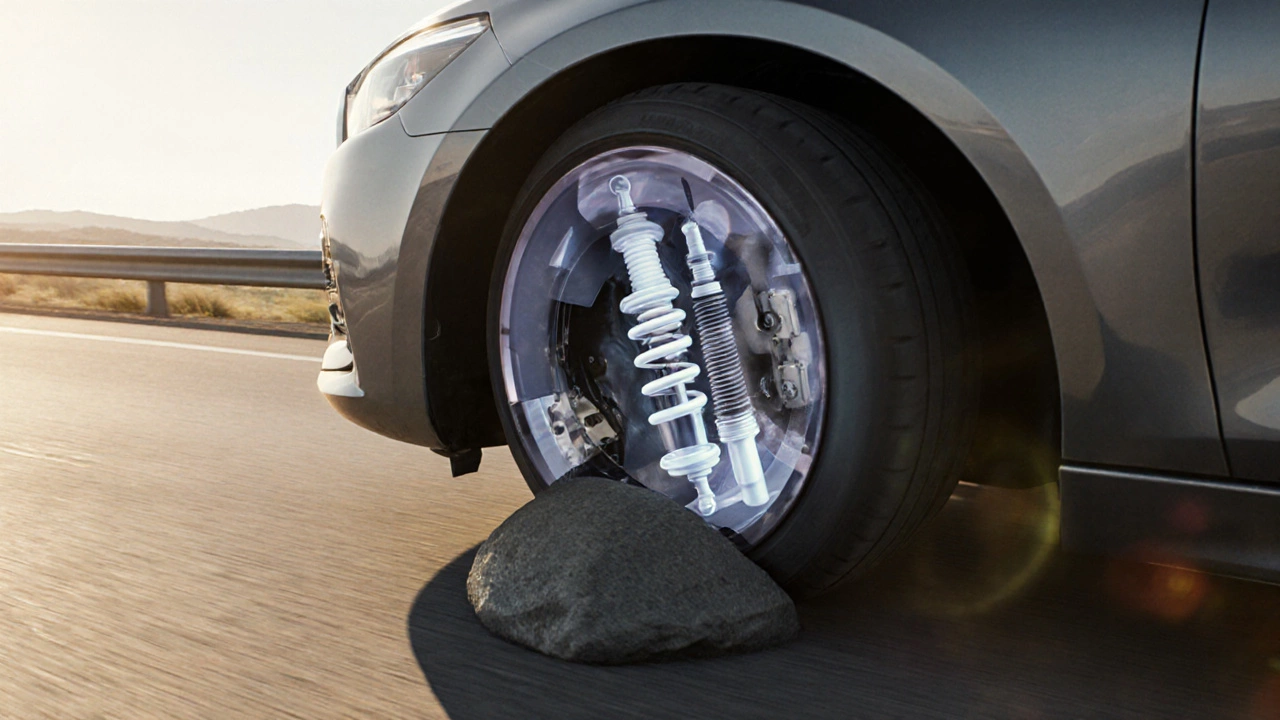Vehicle Suspension Selector Tool
Choose your priority factors
Select your main needs to get personalized suspension recommendations
Recommended Suspension
Select your criteria to see your recommendation
Suspension Type Comparison
| Type | Best For | Pros | Cons |
|---|---|---|---|
| Solid Axle | Off-road, heavy hauling | Durable, high load capacity | Heavy, less precise handling |
| MacPherson Strut | Daily commuting | Compact, lightweight, inexpensive | Limited camber adjustment |
| Double Wishbone | Performance driving | Precise control, excellent grip | Complex, higher cost |
| Multi-link | Luxury comfort | Smooth ride, adaptable geometry | Complex, higher repair cost |
Ever wondered why some cars hug the road while others feel like they’re bouncing on a trampoline? The secret lies in the suspension system, and most modern vehicles fall into one of four basic designs. Knowing the differences helps you talk the language of mechanics, pick the right ride for your needs, and avoid costly surprises during maintenance.
What is a vehicle suspension?
When a car hits a bump, the vehicle suspension is the collection of components that links the wheels to the chassis, controls wheel motion, and absorbs road shocks. It keeps the tires in contact with the road, stabilizes the body, and provides comfort. Think of it as the bridge between raw road energy and the cabin where you sit.
1. Solid axle suspension
The solid axle is a rigid beam connecting the left and right wheels, moving as one unit is the oldest and toughest design. It’s common on trucks, off‑roaders, and some older sedans.
- Key parts: leaf springs, a live axle housing, and a pair of shock absorbers.
- Why it works: The axle’s mass and the leaf springs create a sturdy platform that can handle heavy loads.
- Pros: Excellent durability, simple geometry, easy to service.
- Cons: Heavier, less precise wheel control, can feel stiff on smooth roads.
Typical applications include pickup trucks that haul cargo, SUVs that tackle rough trails, and classic cars prized for their nostalgic feel.
2. MacPherson strut suspension
The MacPherson strut combines a shock absorber and a coil spring into a single upright assembly that also acts as a steering pivot dominates front‑end designs on compact cars and many midsize models.
- Key parts: coil spring, strut damper, steering knuckle, and a lower control arm.
- Why it works: By stacking the spring and damper, engineers save space and reduce weight.
- Pros: Compact, lightweight, cost‑effective, good handling for everyday driving.
- Cons: Limited camber adjustment, can wear out faster on harsh roads.
Most front‑wheel‑drive hatchbacks you see on city streets use a MacPherson strut because it packs performance into a small package.

3. Double wishbone suspension
The double wishbone employs two triangular control arms (upper and lower) that guide the wheel while keeping the camber angle stable is the go‑to for sports cars and high‑end sedans.
- Key parts: upper and lower wishbones, coil spring, shock absorber, and often an anti‑roll bar.
- Why it works: Separate upper and lower arms let engineers fine‑tune camber, caster, and toe independently.
- Pros: Precise wheel control, excellent handling, adaptable to different ride heights.
- cons: More complex, higher manufacturing cost, takes up more space.
Cars that pride themselves on cornering agility-think of a Porsche 911 or a performance version of the BMW 3 Series-often feature a double wishbone front or rear setup.
4. Multi‑link suspension
The multi‑link uses three or more arms of varying lengths to control wheel movement in multiple directions is the most versatile modern design, especially for rear axles.
- Key parts: multiple control arms, coil spring, damper, and sometimes a trailing arm.
- Why it works: Independent links allow engineers to isolate vertical motion from toe and camber changes.
- Pros: Superior ride comfort, excellent handling balance, adaptable to many vehicle sizes.
- Cons: Complex geometry, higher parts count, can be pricey to repair.
Luxury SUVs, performance coupes, and many modern sedans rely on multi‑link rear suspensions to blend comfort with sporty dynamics.
Quick comparison of the four types
| Design | Typical Use | Pros | Cons | Cost |
|---|---|---|---|---|
| Solid axle | Trucks, off‑roaders | Durable, simple, high load capacity | Heavy, less precise handling | Low |
| MacPherson strut | Compact cars, front‑wheel‑drive | Compact, lightweight, inexpensive | Limited camber adjustment | Low‑to‑mid |
| Double wishbone | Sports cars, performance sedans | Precise wheel control, excellent grip | Complex, higher manufacturing cost | Mid‑to‑high |
| Multi‑link | Luxury SUVs, modern sedans | Balanced ride, adaptable geometry | Complex, higher repair cost | Mid‑to‑high |

How to pick the right suspension for your vehicle
Pick a design that matches three practical factors:
- Purpose: If you haul gear or go off‑road, a solid axle or multi‑link rear gives you load capacity. For daily commuting, a MacPherson strut offers a smooth ride at a bargain.
- Driving style: Track‑day enthusiasts gravitate toward double wishbones for razor‑sharp cornering. Casual drivers usually prefer the comfort of a multi‑link setup.
- Budget: Replacement parts for solid axles and MacPherson struts are widely available and cheap. Double wishbone and multi‑link components can cost more, especially if you need OEM‑spec parts.
Remember, the suspension works with springs devices that store energy when compressed and release it to smooth out bumps and shock absorbers hydraulic or gas‑filled cylinders that dampen spring oscillations. Upgrading just the struts while ignoring worn springs can lead to uneven wear and a harsh ride.
Common maintenance issues across all suspension types
Even the toughest design can develop problems. Here are the usual suspects:
- Worn bushings: Rubber or polyurethane inserts can crack, causing clunking noises.
- Leaking shocks or struts: Red fluid on the wheel well means the damper isn’t sealing properly.
- Spring sag: Over‑compressed springs lose their ability to rebound, leading to a nose‑down attitude.
- Misaligned components: A bent control arm or a loosened mounting bolt throws off camber and toe, affecting tire wear.
Regular visual checks, a basic bounce test, and a professional alignment every 12 000 miles keep any suspension system healthy.
FAQ
What does a solid axle actually look like?
It’s a single metal tube that runs across the vehicle’s width, with a leaf‑spring pack mounted on top. Both wheels are attached to the same rigid piece, so they move together.
Can I swap a MacPherson strut for a double wishbone?
Swapping isn’t a simple bolt‑on job. The chassis, steering rack, and mounting points are engineered for a specific geometry, so you’d need a custom subframe or a different vehicle platform.
Which suspension type offers the best ride comfort?
Multi‑link setups generally provide the smoothest ride because each arm can be tuned to isolate road inputs, while still allowing precise wheel control.
How often should I replace my shock absorbers?
Most manufacturers recommend 80 000‑100 000 km, but if you notice excessive bouncing, fluid leaks, or uneven tire wear, replace them sooner.
Do all cars use an anti‑roll bar?
Nearly every modern vehicle includes at least one anti‑roll bar, either front or rear, to limit body roll during cornering. Performance models may have two.
Understanding the four major suspension types gives you the vocabulary to discuss upgrades, diagnose noises, and choose a vehicle that matches your driving habits. Whether you’re a weekend off‑roader, a daily commuter, or a track enthusiast, the right suspension makes every mile smoother.




